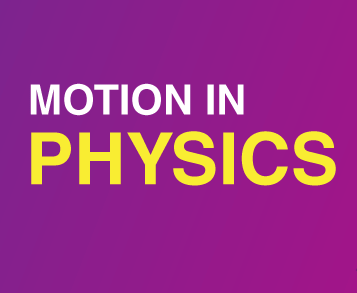Scalar Quantities: Physical quantities which have magnitude only and no direction are called scalar quantities.
Example: Mass, speed, volume, work, time, power, energy etc.
Vector Quantities: Physical quantities which have magnitude and direction both and obey triangle law are called vector quantities.
Example: Displacement, velocity, acceleration, force, momentum, torque etc.
*Electric current, though has a direction, is a scalar quantity because it does obey triangle law.
Distance: Distance is the length of actual path covered by a moving object in a given time interval.
Displacement: Shortest distance covered by a body in a definite direction is called displacement.
>> Distance is a scalar quantity whereas displacement is a vector quantity but bodies having the same unit (metre)
>> Displacement may be positive, negative or zero whereas distance is always posiüve. In general, magnitude of displacement < distance
Speed: Distance travelled by the moving object in unit time interval is called speed i.e.
speed = Distance/ Time
It is a scalar quantity and its SI unit is metre/second (m/s)
Velocity: Velocity of a moving object is defined as thé displacement in unit time interval i.e. velocity = Displacement/ Time
It is a vector quantity and its SI unit is metre/second (m/s)
Acceleration: Acceleration of an object is defined as the rate of change velocity of the object i.e.
Acceleration= Change in Velocity/ Time
It is a vector quantity and its SI units is metre/second2 (m/s2)
If velocity decreases with time then acceleration is negative and is called retardation.
Circular Motion: If an object describes a circular path (circle) its motion is called circular motion. If the object moves with uniform speed, its motion is uniform circular motion.
Uniform circular motion is an accelerated motion because the direction of velocity changes continuously, though the magnitude of velocity i.e. speed of the body remains unchanged.
Newton’s laws of motion: Newton, the father of physics established the laws of motion in his book “principia” in 1687.
Newton’s first law of motion: Everybody maintains its initial state of rest or motion with uniform speed on a straight line unless an external force acts on it.
>> First law is also called law of Galileo or law of inertia.
>> Inertia: Inertia is the property of a body by virtue of which the body opposes change in its initial state of rest or motion with uniform speed on a straight line.
Some examples of Inertia:
1. When a car or train starts suddenly, the passengers bends backward. 2. When a running horse stops suddenly, the rider bends forward. 3. When a coat/blanket is beaten by a stick, the dust particles are removed.
>> First law gives the definition of force.
>> Force: Force is that external cause which when acts on a body changes or tries the initial state of rest or motion with uniform velocity of the body.
Momentum: Momentum is the property of a moving body and is defined as Product of mass and velocity of the body. i.e.
Momentum=mass x velocity
It is a vector quantity. Its SI unit is kgm/s.
Newton’s second law of motion: The rate of change in momentum of a body is directly proportional to the applied force on the body and takes place in the direction of force.
If F=force applied, a = acceleration produced and m = mass of body then F=ma
>> Newton’s second law gives the magnitude of force.
>> Newton’s first law is contained in the second law.
Newton’s Third Law of Motion: To every action, there is an equal and opposite reaction.
Examples of third law— 1. Recoil of a gun 2.Motion of rocket 3.Swimming 4. While drawing water from the well, if the string breaks up the man drawing water falls back.
Principle of conservation of linear momentum: If no external force acts on a system of bodies, the total linear momentum of the system of bodies remains constant. As a consequence, the total momentum of bodies before and after collision remains the same.
Rocket works on the principle of conservation of linear momentum.
Impulse: When a large force acts on a body for very small time, then force is called impulsive force. Impulse is defined as the product of force and time. Impulse = force x time = change in momentum.
>> It is a vector quantity and its direction is the direction of force. Its SI unit is newton second (NS)
Centripetal Force : When a body travels along a circular path, its velocity changes continuously. Naturally an external force always acts on the body towards the centre of the path.
The external force required to maintain the circular motion of the body is called centripetal force.
If a body of mass m is moving on a circular path of radius R with uniform speed v, then the required centripetal force, F = mv2/R
Centrifugal Force: In applying the Newton’s laws of motion, we have to consider some forces which can not be assigned to any object in the surrounding. These forces are called pseudo force or inertial force.
Centrifugal force is such a pseudo force. It is equal and opposite to centripetal force.
>> Cream separator, centrifugal drier work on the principle of centrifugal force. >> Centrifugal force should not be confused as the reaction to centripetal force because forces of action and reaction act on different bodies.
Moment of force: The rotational effect of a force on a body about an axis of rotation is described in terms of moment of force.
Moment of a force about an axis of rotation is measured as the product of magnitude of force and the perpendicular distance of direction of force from the axis of rotation, i.e. Moment of force = Force x moment arm
> It is a vector quantity. Its SI unit is newton metre (Nm)
Centre of Gravity: The centre of gravity of a body is that point through which the entire weight of body acts. The centre of gravity of a body does not change with the change in orientation of body in space.
The weight of a body acts through centre of gravity in the downward direction. Hence a body can be brought to equilibrium by applying a force equal to its weight in the vertically upward direction through centre of gravity.
Equilibrium: If the resultant of all the forces acting on a body is zero then the body is said to be in equilibrium.
If a body is in equilibrium, it will be either at rest or in uniform motion. If it is at rest, the equilibrium is called static, otherwise dynamic.
Conditions for stable Equilibrium : For stable equilibrium of a body, the following two conditions should be fulfilled.
1. The centre of gravity of the body should be at the minimum height. 2. The vertical line passing through the centre of gravity of the body should Pass through the base of the body.



